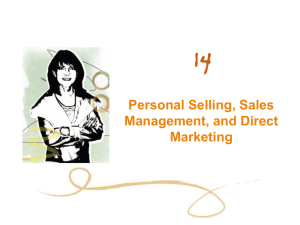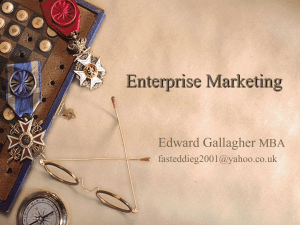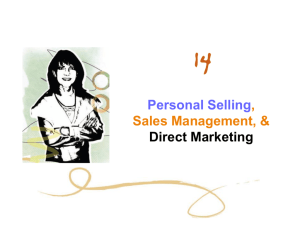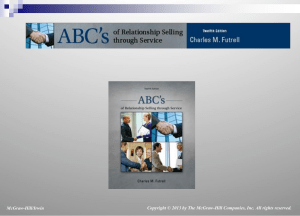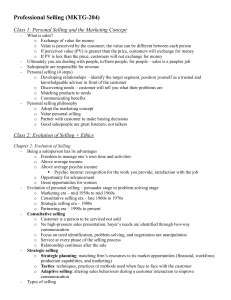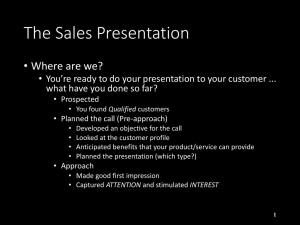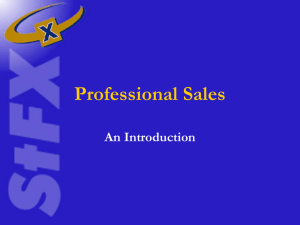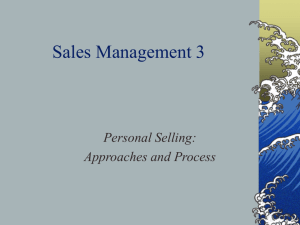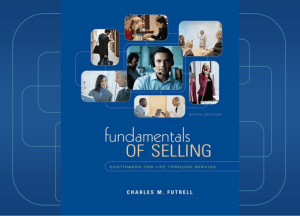Chapter 14 - The Citadel
advertisement
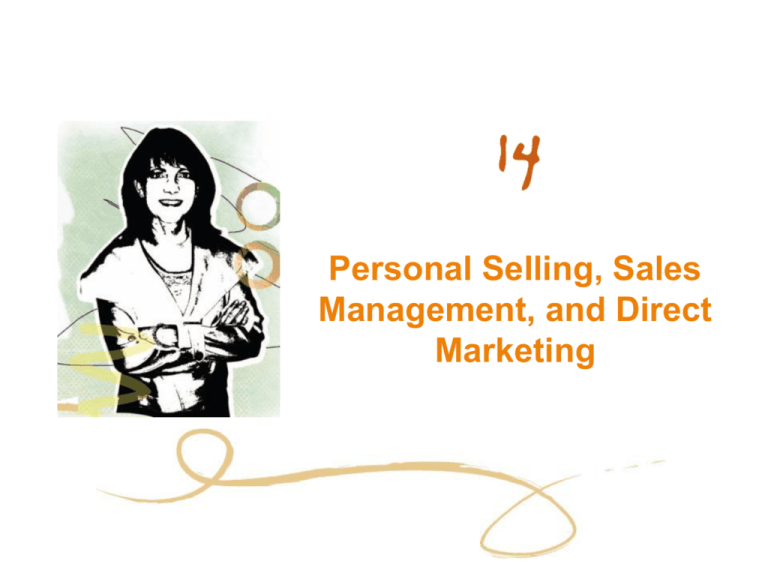
Personal Selling, Sales Management, and Direct Marketing Chapter Objectives • Understand the important role of personal selling within the context of the promotion mix • List the steps in the personal selling process • Explain the role of the sales manager • Understand direct marketing 2 Real People, Real Choices • IBM (Esther Ferre) • IBM must prioritize investment of resources to achieve revenue and profit targets. Option 1: reduce sales and support resources for a specific customer or business segment. Option 2: maintain current level of resources. Option 3: evaluate lower-cost ways to provide sales and support resources. 3 Personal Selling • Occurs when a company representative interacts directly with a (prospective) customer to communicate about a good or service “Personal touch” is more effective than mass-media appeal. Selling/sales management jobs provide high mobility, especially for college grads with marketing background. 4 The Role of Personal Selling • Personal selling is more important: --when firm uses push strategy. --in B2B contexts. --with inexperienced consumers who need hands-on assistance. --for products bought infrequently (houses, cars, computers). • Cost per contact is very high. 5 Technology and Personal Selling • Customer relationship management (CRM) software and partner relationship management (PRM) • Teleconferencing, videoconferencing, and improved corporate Web sites • Voice-over Internet protocol • Assorted wireless technologies 6 Types of Sales Jobs • Order taker • Technical specialist • Missionary salesperson (stimulate clients to buy) • New-business salesperson and order getter • Team selling and cross-functional team 7 Approaches to Personal Selling • Transactional selling: Putting on the hard sell High-pressure process that focuses on making an immediate sale with no concern for developing longterm customer relationship 8 Approaches to Personal Selling (cont’d) • Relationship selling Process of building long-term customers by developing mutually satisfying, win-win relationships with customers 9 The Creative Selling Process • Step 1: Prospecting and qualifying --Prospecting: developing a list of potential customers --Qualifying: determining how likely potential customers are to become customers 10 Step 2: Preapproach • Compiling background information about prospective customers and planning the sales interview --Purchase history, current needs, customer’s interests --From informal sources, CRM system, customers’ Web sites, and/or business publications 11 Step 3: Approach • Contacting the prospect • Learning even more about prospect’s needs, create a good impression, and build rapport • --“You never get a second • chance to make a good • first impression.” 12 Step 4: Sales Presentation • Laying out benefits and added value of product/firm and its advantages over the competition • Inviting customer involvement in conversation 13 Step 5: Handling Objections • Anticipating why prospect is reluctant to make a commitment • Welcoming objections • Handling objections successfully to move prospect to decision stage 14 Step 6: Closing the Sale • Gaining the customer’s commitment in the decision stage --Last-objection close --Assumptive or minor-points close --Standing-room-only or buy-now close 15 Step 7: Follow-Up • Arranging for delivery, payment, and purchase terms • Making sure customer received delivery and is satisfied • Bridging to next purchase 16 Sales Management • Setting sales force objectives What sales force is expected to accomplish and when Customer satisfaction, loyalty, retention/turnover, new-customer development, new-product suggestions, training, reporting on competitive activity, community involvement 17 Creating a Sales Force Strategy • Establishing structure and size of a firm’s sales force • Sales territory: a set group of customers Geographic sales force structure Product-class sales territories Industry specialization and key/major accounts 18 Recruiting, Training, and Rewarding the Sales Force • Recruiting the right people Good listening and follow-up skills Ability to adapt style from situation to situation Tenacity High level of personal organization • Sales training: teaches salespeople about firm, its products, how to develop skills, knowledge, and attitudes to succeed 19 Recruiting, Training, and Rewarding the Sales Force (cont’d) • Paying salespeople well to motivate them Straight commission plan Commission-with-draw plan Straight salary plan • Running sales contests for short-term sales boost • Call reports: which customers were called on and how call went 20 Evaluating the Sales Force • Is sales force meeting its objectives? • What are possible causes of failure? Measuring individual salesperson performance Monitoring salesperson’s expense account for travel and entertainment 21 Direct Marketing • Any direct communication to a consumer or business recipient designed to generate a response in the form of an order, a request for further information, and/or a visit to a store or other place of business for purchase of a product 22 Direct Marketing (cont’d) • Mail order Catalogs: collection of products offered for sale and described in book form, usually consisting of product descriptions and photos Direct mail: a brochure/pamphlet offering a specific good/service at one point in time 23 Direct Marketing (cont’d) • Telemarketing: direct marketing conducted over the telephone More profitable for business than consumer markets In 2003, FTC established National Do Not Call registry 24 Direct Marketing (cont’d) • Direct-response advertising: allows consumer to respond by contacting the provider with questions or an order Direct-response TV (DRTV): short commercials, 30minute-plus infomercials, and home shopping networks 25 Direct Marketing (cont’d) • M-Commerce: promotional and other ecommerce activities transmitted over mobile phones/devices Short-messaging system marketing (SMS) Spim: instant-messaging version of spam Adware: software that tracks Web habits/interests, presenting pop-up ads and resetting home page 26 Real People, Real Choices • IBM (Esther Ferre) • Esther chose option 3: evaluate lower-cost ways to provide sales and support resources. Minimized impact to customer and improved cost structure of sales team. Maintained customer satisfaction with lower cost. Resulted in increased revenue over time. 27 Marketing in Action Case: You Make the Call • What is the decision facing Eli Lilly? • What factors are important in understanding this decision situation? • What are the alternatives? • What decision(s) do you recommend? • What are some ways to implement your recommendation? 28 Keeping It Real: Fast-Forward to Next Class, Decision Time at Darden Restaurants • Meet Jim Lawrence, Vice President, Supply Management & Purchasing. • Volatility in the supply chain threatened food supplies to restaurants. • The decision: A new model for supply chain management? 29
